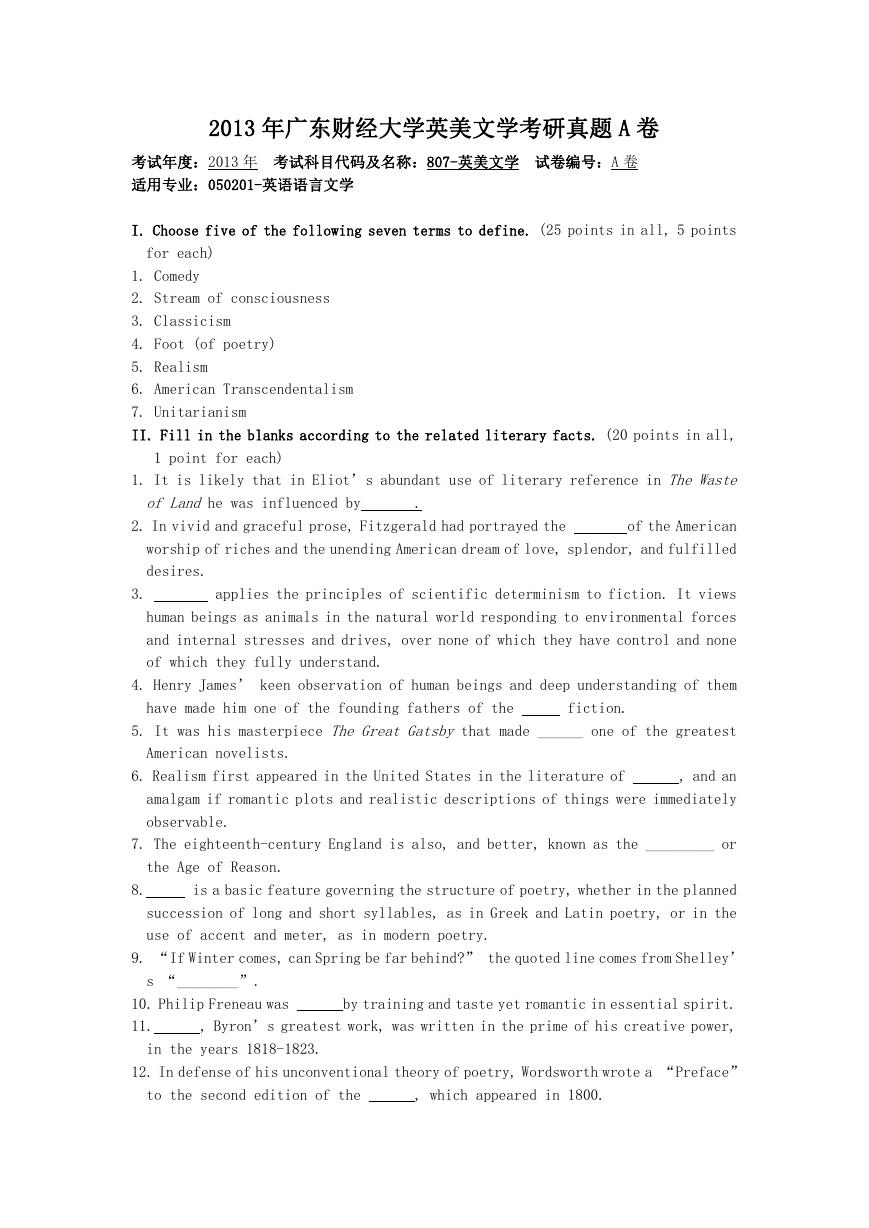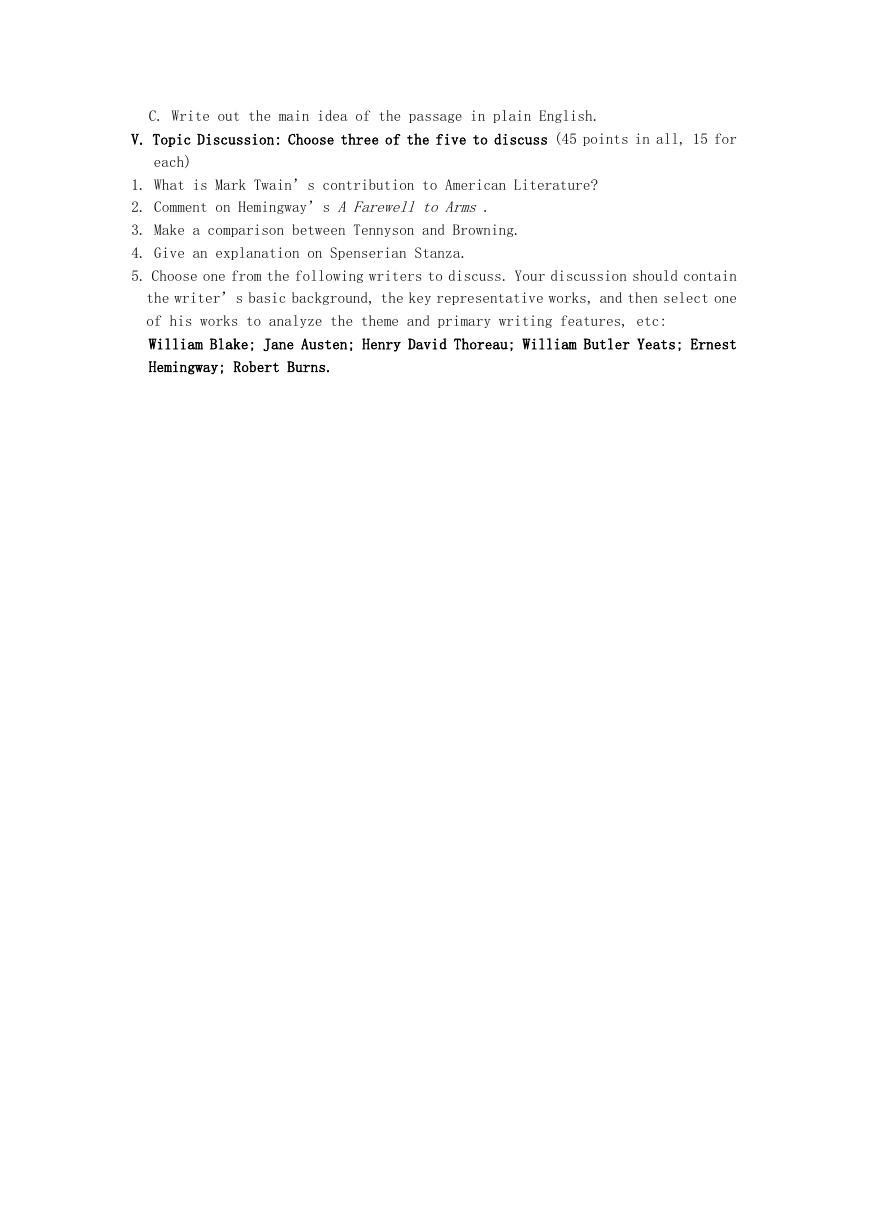2013 年广东财经大学英美文学考研真题 A 卷
考试年度:2013 年 考试科目代码及名称:807-英美文学 试卷编号:A 卷
适用专业:050201-英语语言文学
I. Choose five of the following seven terms to define. (25 points in all, 5 points
for each)
1. Comedy
2. Stream of consciousness
3. Classicism
4. Foot (of poetry)
5. Realism
6. American Transcendentalism
7. Unitarianism
II. Fill in the blanks according to the related literary facts. (20 points in all,
1 point for each)
1. It is likely that in Eliot’s abundant use of literary reference in The Waste
of Land he was influenced by
.
2. In vivid and graceful prose, Fitzgerald had portrayed the
of the American
worship of riches and the unending American dream of love, splendor, and fulfilled
desires.
3.
applies the principles of scientific determinism to fiction. It views
human beings as animals in the natural world responding to environmental forces
and internal stresses and drives, over none of which they have control and none
of which they fully understand.
4. Henry James’ keen observation of human beings and deep understanding of them
have made him one of the founding fathers of the
fiction.
5. It was his masterpiece The Great Gatsby that made ______ one of the greatest
American novelists.
6. Realism first appeared in the United States in the literature of
, and an
amalgam if romantic plots and realistic descriptions of things were immediately
observable.
7. The eighteenth-century England is also, and better, known as the _________ or
the Age of Reason.
8.
is a basic feature governing the structure of poetry, whether in the planned
succession of long and short syllables, as in Greek and Latin poetry, or in the
use of accent and meter, as in modern poetry.
9. “If Winter comes, can Spring be far behind?” the quoted line comes from Shelley’
s “________”.
10. Philip Freneau was
11.
by training and taste yet romantic in essential spirit.
, Byron’s greatest work, was written in the prime of his creative power,
in the years 1818-1823.
12. In defense of his unconventional theory of poetry, Wordsworth wrote a “Preface”
to the second edition of the
, which appeared in 1800.
�
13. In the autobiographical account of the childhood, growth and maturity
of
, Dickens is actually retracing his own life..
14. _______ is concerned both with how the meaning of a literary work is affected
when read from a woman’s perspective and how female characters and women in general
are treated within the work.
15.
is a riddle which has meant so many things to so many people. Even today
it is still hard for people to come to a universally accepted understanding of
the book. It is small wonder Clement Shorter would call its author “the sphinx
of our modern literature”.
16. Lawrence’s most controversial novel is
17.
is term in poetry applied to two successive lines of verse that form a
single unit because they rhyme; the term also is often used for lines that express
a complete thought or form a separate stanza.
.
18. The central theme of John Milton’s “
” is taken from the Bible and
deals with the Christian story of “the fall of man”.
19. The puritans believed in
20. Geoffrey Chaucer, the “
in life.
” and one of the greatest narrative poets of
England, was born in London in or about the year 1340.
E. The Rainbow
F. A Portrait of the Artist as a Young Man
)
)
)
)
A. When You Are Old
)
)
)
D. The Mill on the Floss
B. Idylls of the King
C. Sister Carrie
III. Match the writers with their works. (20 points in all, 1 point for each)
1. William Thackeray (
2. William Shakespeare (
3. Jonathan Swift (
4. Thomas Hardy(
5. James Joyce(
6. William Butler Yeats(
7. Charles Dickens(
)
8. Jane Austen(
)
9. Nathaniel Hawthorne(
10. Alfred Tennyson(
)
11. John Bunyan (
12. G. B. Shaw(
13. Thomas Gray(
)
14. David Lawrence (
15. Thomas More (
16. George Eliot(
17. Edmund Spenser(
18. Theodore Dreiser(
)
19. Thomas Stearns Eliot(
20. George Orwell(
G. The Waste Land
H. Gulliver’s Travels
I. Far from the Madding Crowd
J. Utopia
R. Elegy Written in a Country Churchyard
S. Vanity Fair
Q. The Pilgrim's Progress
N. Pride and Prejudice
O. The Scarlet Letter
L. Othello
M. Animal Farm
K. Widower’s Houses
)
)
)
)
)
)
)
T. The Faerie Queen
)
P. Hard Times
IV. Read the following selections and then answer the questions as you are required
according to your comprehension. (40 points in all, 8 points for each)
1.“I shall be telling this with a sigh
Somewhere ages and ages hence:
�
Two roads diverged in a wood,and I—
I took the one less traveled by,
And that has made all the difference.”
Questions:
A. Identify the poem and the poet.
B. What does the phrase “ages and ages hence” mean?
C. What idea does the quoted passage express?
2. “When the minister spoke from the pulpit, with power and fervid eloquence,
and with his hands on the open bible, of the sacred truths of our religion, and a
saint –like lives and triumphant deaths, and of future bliss or misery unutterable,
then did Goodman Brown turn pale, dreading, lest the roof should thunder down upon
the gray blasphemer and his hearers.”
Questions:
A. Identify the title of the short story from which this part is taken and the
author.
B. What had happened in the story before this church scene?
C. Why was Goodman Brown afraid that the roof might thunder down?
3. “One short sleep past, we wake eternally
And death shall be no more; death, thou shalt die.”
Questions:
A. Identify the poem and the poet.
B. What does the word “sleep” mean?
C. What idea do the two lines express?"
4. “Nor lose possession of that fair thou owest;
Nor shall Death brag thou wanderest in his shade,
When in eternal lines to time thou growest:
So long as men can breathe, or eyes can see,
So long lives this, and this gives life to thee.”
Questions:
A. Identify the poem and the poet.
B. Discuss BRIEFLY the main idea of the stanza or of the whole canto.
C. What are the possible implications of the last two lines?h
5. “For oft, when on my couch I lie
In vacant or in pensive mood,
They flash upon that inward eye
Which is the bliss of solitude;
And then my heart with pleasure fills,
And dances with the daffodils.”
Questions
A. Identify the author and the title.
B. What does the phrase “inward eye” mean?
�
C. Write out the main idea of the passage in plain English.
V. Topic Discussion: Choose three of the five to discuss (45 points in all, 15 for
each)
1. What is Mark Twain’s contribution to American Literature?
2. Comment on Hemingway’s A Farewell to Arms .
3. Make a comparison between Tennyson and Browning.
4. Give an explanation on Spenserian Stanza.
5. Choose one from the following writers to discuss. Your discussion should contain
the writer’s basic background, the key representative works, and then select one
of his works to analyze the theme and primary writing features, etc:
William Blake; Jane Austen; Henry David Thoreau; William Butler Yeats; Ernest
Hemingway; Robert Burns.
�








 2023年江西萍乡中考道德与法治真题及答案.doc
2023年江西萍乡中考道德与法治真题及答案.doc 2012年重庆南川中考生物真题及答案.doc
2012年重庆南川中考生物真题及答案.doc 2013年江西师范大学地理学综合及文艺理论基础考研真题.doc
2013年江西师范大学地理学综合及文艺理论基础考研真题.doc 2020年四川甘孜小升初语文真题及答案I卷.doc
2020年四川甘孜小升初语文真题及答案I卷.doc 2020年注册岩土工程师专业基础考试真题及答案.doc
2020年注册岩土工程师专业基础考试真题及答案.doc 2023-2024学年福建省厦门市九年级上学期数学月考试题及答案.doc
2023-2024学年福建省厦门市九年级上学期数学月考试题及答案.doc 2021-2022学年辽宁省沈阳市大东区九年级上学期语文期末试题及答案.doc
2021-2022学年辽宁省沈阳市大东区九年级上学期语文期末试题及答案.doc 2022-2023学年北京东城区初三第一学期物理期末试卷及答案.doc
2022-2023学年北京东城区初三第一学期物理期末试卷及答案.doc 2018上半年江西教师资格初中地理学科知识与教学能力真题及答案.doc
2018上半年江西教师资格初中地理学科知识与教学能力真题及答案.doc 2012年河北国家公务员申论考试真题及答案-省级.doc
2012年河北国家公务员申论考试真题及答案-省级.doc 2020-2021学年江苏省扬州市江都区邵樊片九年级上学期数学第一次质量检测试题及答案.doc
2020-2021学年江苏省扬州市江都区邵樊片九年级上学期数学第一次质量检测试题及答案.doc 2022下半年黑龙江教师资格证中学综合素质真题及答案.doc
2022下半年黑龙江教师资格证中学综合素质真题及答案.doc